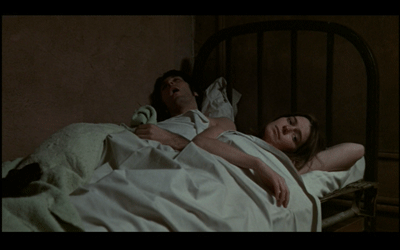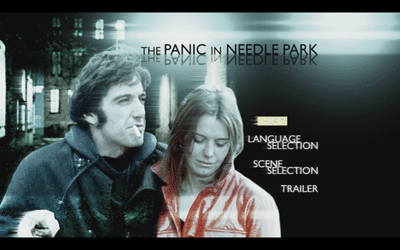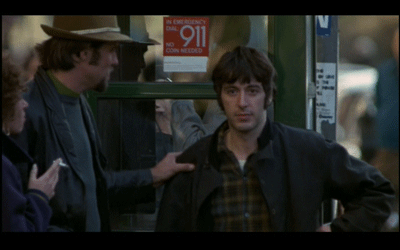| Reviews & Columns |
|
Reviews DVD TV on DVD Blu-ray 4K UHD International DVDs In Theaters Reviews by Studio Video Games Features Collector Series DVDs Easter Egg Database Interviews DVD Talk Radio Feature Articles Columns Anime Talk DVD Savant Horror DVDs The M.O.D. Squad Art House HD Talk Silent DVD
|
DVD Talk Forum |
|
|
| Resources |
|
DVD Price Search Customer Service #'s RCE Info Links |
|
Columns
|
|
|
Panic in Needle Park, The
THE MOVIE:

Needle Park was a real area in New York City where junkies congregated, forming their own city within the larger city, getting by on the hustle and the routine of cop/shoot/cop. The Panic in Needle Park is a 1971 film about this area, adapted from a book by James Mills. It's written by two of the finest writers in journalistic literature at that time, Joan Didion and John Gregory Dunne, and they apply the same feeling of honest reportage that had earned them their reputation to this screenplay. From there, director Jerry Schatzberg (Scarecrow, Honeysuckle Rose) picked up the gauntlet and shot the movie in a verite style that anticipates the hand-held documentary approach cop shows like Homicide: Life on the Streets and NYPD Blue would use two decades later. This makes The Panic in Needle Park a raw, honest film about the junkie lifestyle, and how love can be corrupted when it burns in the center of a heroin spoon.
Al Pacino plays Bobby, your standard hustler who spends his days kidding others in order to keep telling lies to himself. When we first meet him, he's slinging marijuana and claiming to only be shooting up occasionally. Helen (Kitty Winn, The Exorcist) is the sickly girlfriend of one of Bobby's customers (Raul Julia), and during one of her many stays in the hospital, the boyfriend runs out on her. Acting on unspoken affection, Bobby picks her up when she's discharged, and from there, a love affair quietly begins.
Things start easily enough, and it would seem that Bobby gets by pretty well. The addicts form their own little community, and amongst them, he appears to have his feet firmly on the ground. He's definitely a charismatic guy, and how could he not be? He's played by Al Pacino, for gosh sake. His manner draws Helen in, probably because she lacks any consistency in her own life. We don't know what happened to her to make her this way--both characters pretty much start at ground zero and don't speak of the past--but the two fit in a way that you don't often see in even straightforward love stories.
Eventually, though, Bobby is going to push the boundaries of their relationship. The crucial scene comes when he asks Helen to go uptown and score for him. She looks him dead in the eye and calls him on it: he's testing her to see what lengths she'll go to in their relationship. It's shortly after this that she tries heroin for the first time. Helen never explains why she sneaks a hit from Bobby's stash, but it's presumably to be closer to him. It's the one thing he cares about more than her. He won't even make love to her when he's stoned. It's like she's conquering the mistress by taking her to bed.
The Panic in Needle Park is told in a loping matter, the plot coming in great big chunks like an asteroid storm rather than a carefully arranged line. It's an ambling gait, though, and never a rambling one. The illusion is that it's accidental, when really the writing and editing is very precise. Realism is the order of the day. Schatzberg doesn't come off as an assertive director, his style is too natural, and he lets his actors be natural. It's one of those movies where the people seem to just exist on the screen rather than a collection of actors performing. It was only Pacino's second movie, and he already looks at home on camera.
This naturalism is a bit of a sucker punch for the audience, because it allows Schatzberg to sneak the more harrowing elements into the picture and catch us off guard. The drug scenes are casually gruesome in a way that is chillingly effective. There is no exploitation of the drug culture in The Panic in Needle Park, no romantic images of junkies getting off and having a grand time. Whenever we see a needle breaking skin, it's usually penetrating a scabrous or bruised vein, and the stupor that follows is anything but attractive. Likewise, when the random outbreak of violence enters into the scene, Schatzberg makes sure we feel the impact of it, as well. His on-the-spot shooting style suddenly grows more manic, moving in tight on the action, often losing focus altogether. It makes those moments seem more vicious, like there was no way to stop them.
The Panic in Needle Park grows more grisly as it goes. The "panic" referred to is actually a term for a period of time when there aren't a lot of drugs on the market. It makes people desperate and forces them to turn on each other. For Bobby and Helen, that means finding new ways to score. They tend to choose opposite directions for how to get ahold of their junk, and it will be the test of their relationship if they can stay together. Didion and Dunne avoid moralizing, and they mainly avoid being heavy handed about the more extreme consequences of addiction. (I say mainly because bringing that puppy into it, guys, steps close to the line.) The downward slide is disconcerting enough without also giving us the loud thump of the couple hitting rock bottom--which is also probably why the movie still feels fresh and timely after all these years. The Panic in Needle Park is as much about the relationship as it is the habit, anyway, and the writers serve both masters well. The movie ends with a perfect little snippet of a scene, striking the right kind of resonance, saying it all without having to say too much.

THE DVD
Video:
The Panic in Needle Park is a flipper disc, with a full screen version on one side and an anamorphic widescreen (1.85:1) on the other. For my main viewing, I opted for the widescreen, and it was a fairly conscientious transfer. Very little by way of any surface spots or scratches, with only a little edge enhancement in various spots and generally natural looking colors. The blacks aren't very solid, noticeable in some of the darker night scenes, but overall, a fair job.
I sampled the full frame version and it seemed okay, too. Obviously, the cropping can be pretty tight, and you don't get nearly as much of a feel for the city in the outdoor scenes. The colors seemed a tad more muted, as well. Based on the dilapidated 20th Century Fox logo at the start of the film, you would be forgiven thinking that the full frame didn't get much of a clean-up at all, but it looks to be pretty close to the same quality as the widescreen.
Sound:
The original English audio is in both stereo and mono. The stereo sounded kind of spread out to me, so I switched over to the mono, and I think it actually sounds better. It's more direct, putting the dialogue right in the center, as opposed to trying to go for the full expanse of the street scenes. Naturally, this is a matter of taste. Take your pick. Or go all out and watch the mono mix in French if you want to get nuts about it.
Subtitles are in English and Spanish, and there is Closed Captioning.
Extras:
Both sides of the DVD have the theatrical trailer, which sells The Panic in Needle Park as a little more lurid than the movie actually is. It features exploitation-style voiceover from one of the usual trailer narrator guys, as well as a monologue voiceover by Kitty Winn.
FINAL THOUGHTS:
A barebones DVD of a close to the bone movie, The Panic in Needle Park is Recommended. Using an on-the-spot camera style and real locations, director Jerry Schatzberg creates an honest account of how a young couple gets by with the opposing habits of love and drugs. A young Al Pacino, in his second ever film role, already displays a real onscreen charisma, and he and the rest of the talented cast deliver naturalistic performances that work with the gritty camera style but also make the tragedy all the more potent. As a film that asks how far two people will go to feed their addiction, The Panic in Needle Park goes as far as it needs to itself. It doesn't flinch, nor does it preach, and its grisly arrival at its final destination chills right to the marrow.

Jamie S. Rich is a novelist and comic book writer. He is best known for his collaborations with Joelle Jones, including the hardboiled crime comic book You Have Killed Me, the challenging romance 12 Reasons Why I Love Her, and the 2007 prose novel Have You Seen the Horizon Lately?, for which Jones did the cover. All three were published by Oni Press. His most recent projects include the futuristic romance A Boy and a Girl with Natalie Nourigat; Archer Coe and the Thousand Natural Shocks, a loopy crime tale drawn by Dan Christensen; and the horror miniseries Madame Frankenstein, a collaboration with Megan Levens. Follow Rich's blog at Confessions123.com.
|
| Popular Reviews |
| Sponsored Links |
|
|
| Sponsored Links |
|
|
| Release List | Reviews | Shop | Newsletter | Forum | DVD Giveaways | Blu-Ray | Advertise |
|
Copyright 2024 DVDTalk.com All Rights Reserved. Legal Info, Privacy Policy, Terms of Use,
Manage Preferences,
Your Privacy Choices | |||||||













